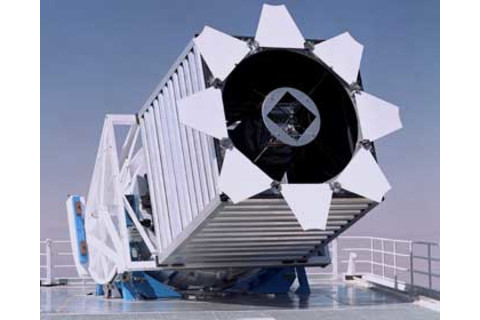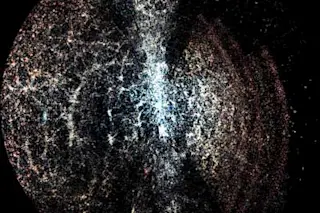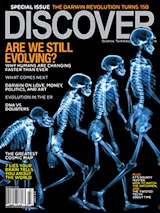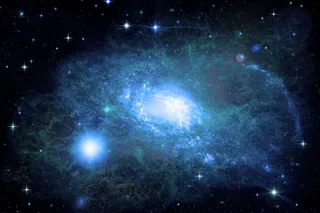Located 9,200 feet above sea level, atop the Apache Point Observatory in Sunspot, New Mexico, the Sloan Digital Sky Survey telescope cannot match the incredibly sharp vision of the Hubble Space Telescope, which orbits above Earth’s blurring atmosphere. And, at a modest 2.5 meters (8 feet) across, the Sloan telescope’s main mirror cannot see the incredibly dim objects that the 10-meter (33-foot) Keck telescopes in Hawaii can. What the Sloan telescope does have in spades is a voracious appetite for sky—an appetite that is producing some of the most amazing discoveries in astronomy.
With its giant set of light-sensitive imaging sensors, the Sloan telescope has a field of view so wide it can image 36 full moons’ worth of sky at once (Hubble, in contrast, is limited to a view less than one-tenth of a moon across). Night after night it scans vast swaths of the heavens and downloads its observations into a 73-terabyte (and growing) digital database that covers almost half the night sky as seen from Apache Point. Swept up in the Sloan’s relentless gaze are stars, galaxies, supernovas, nebulas, and more—over 350 million celestial objects in total—adding up to the most complete census of the universe ever conducted.
The result of all this activity is the Sloan Digital Sky Survey (SDSS), originally established “to determine the large-scale structure of the universe,” says Richard Kron, a University of Chicago astrophysicist and a Sloan survey director. “We wanted to map out the galaxies that form clusters and the clusters that form superclusters.” Achieving this goal required a huge step up from the 1950s-era Palomar Sky Survey, whose photographic plates have guided astronomers to celestial curiosities for decades. “We knew that to make real progress, we needed a hundred times more data,” Kron says. The Sloan survey captures the sky in full color rather than just through red and blue filters, produces images twice as sharp as Palomar’s, and detects objects one-tenth the brightness of those detectable by its predecessor. The Sloan also introduced two huge innovations. First, it delivers all the data in digital form, so the images are easy to categorize and study electronically, even from halfway around the world. Second, it does not just capture sky images; it also gauges the distance to many of the objects—a million galaxies and 100,000 quasars so far—that pass through its field of view, providing a unique three-dimensional perspective on deep space.
The Sloan telescope went into operation in 2000 and has since yielded two landmark surveys, known as SDSS-I and SDSS-II. Last August astronomers affiliated with the project gathered in Chicago to review results from SDSS-II and to prepare for a third survey—SDSS-III, of course—which recently began and will continue until 2014.
Taken together, the Sloan results lay out one of the most astonishing stories in science: The visible universe is merely the foam atop a much grander cosmic sea. The vast majority of what is out there is more dynamic and complicated and just plain weirder than the tiny fraction we knew. Only now are we starting to see the universe as it truly is.
The Universe Is Doubly DarkBy plotting the precise positions of more than 46,000 galaxies in a volume of space approximately 5 billion light-years in diameter, the Sloan Digital Sky Survey has cast some light on the biggest mystery faced by cosmologists today: the nature of dark energy.

The Sloan telescope is housed within a box-shaped wind baffle. | Image courtesy of Fermilab Visual Media Services
Astronomers figured out some years ago that most of the matter of the universe is not in the form of the stuff that makes up stars and planets, you and me. Most of it (83 percent, by the latest estimates) is so-called dark matter, an unknown something—perhaps an invisible, as yet undetected elementary particle. Then the story got even more confusing. In 1998, while plans for the SDSS were being finalized, two teams of observers reported that the cosmos is pervaded by another unseen entity, a force dubbed dark energy. This energy acts like an antigravity force that pushes galaxies apart, making the universe expand faster and faster over time.
The evidence for dark energy came from studies of a kind of exploding star known as a Type 1a supernova. The wonderful characteristic of these stars is that they all seem to explode exactly the same way, producing flare-ups with a predictable luminosity. Knowing the true brightness of a Type 1a supernova allows astronomers to measure its distance by noting how dim it appears in our sky. Those measurements, in turn, can be interpreted to show how the expansion of the universe has changed over time. Examining a number of extremely distant supernovas, researchers inferred the presence of dark energy and managed to measure its abundance. It appears to make up a staggering 70 percent of the universe’s content. (All matter, light and dark, adds up to just 30 percent.)
The findings left researchers with all kinds of new questions. What is dark energy, and how does it act? Was it stronger or weaker in the early years of the universe? Does it vary in intensity from place to place across the cosmos? Scientists also wanted an independent way to confirm the dark energy story told by the Type 1a supernovas. It seemed possible, for example, that these supernovas were not truly uniform, which would invalidate the underlying assumption of the original studies.
A number of researchers, including Ohio State University astrophysicist David Weinberg, realized they might find some answers by looking at the way galaxies are distributed across the universe. The large-scale structure seen today has its origins in the turbulent infancy of the universe. Back then the cosmos was a hot, dense sea of particles, laced with density variations that arose during the very first fraction of a second after the Big Bang. These density variations produced pressure waves that crashed into each other over and over. Eventually, about 400,000 years after the Big Bang, the growing and cooling universe could no longer support these roiling waves. But their imprint remained, frozen in a pattern of high- and low-density distributions of matter that would ultimately develop into vast collections of galaxies and relatively empty cosmic voids.
By merging this concept of the early universe with specific mathematical models of the effects of dark energy, scientists were able to predict a characteristic scale—a typical distance between concentrations of galaxies—that should be evident in the structure of the universe. “Wherever you see a concentration of galaxies today, you should find a slight excess of galaxies—about 1 percent—in a ring a billion light-years across surrounding that concentration,” say's Weinberg, who is the project scientist for SDSS-III.
That is just what the Sloan telescope found, zeroing in on a population of unusually bright red galaxies that were identified by Daniel Eisenstein of the University of Arizona. The results strongly confirm that dark energy is no illusion; there really is an unseen force pushing the universe apart. Future Sloan surveys should help unravel some of that mystery. By accumulating even larger catalogs of how galaxies are distributed through the universe, the Sloan telescope will measure the changing expansion speed of the universe, epoch by epoch, putting various theories of dark energy to the test. “I’m excited,” says Eisenstein, who took over last year as director of the SDSS-III project. “It’s a very robust way to probe dark energy.”
The Milky Way Has a PosseAstronomers have known since the 1920s that our galaxy, the Milky Way, is surrounded by smaller collections of stars, essentially dwarf galaxies. The largest and brightest of these, the Large and Small Magellanic Clouds, are easily seen with the naked eye in the Southern Hemisphere. By the 1990s another 10 such companions had been found; these are much fainter and are visible only through powerful telescopes. But modern cosmological theories say there should be more of these galactic dwarfs—a lot more. The dark matter that outweighs visible matter by five to one should be fragmented, like the blobs in a lava lamp, into clumps with a range of sizes. Under the influence of gravity, each clump would pull regular matter into its center, forming stars and galaxies. The smallest clumps would create tiny galaxies, and there should be dozens or hundreds of them around. So where are they?
The Sloan Digital Sky Survey has bridged some of the gap between theory and observation by finding 15 more dwarf galaxies surrounding the Milky Way. Because the survey covers only one quarter of the sky and must look past various obstacles, both local and cosmic, it probably missed another 60 to 80 similar dwarf galaxies, according to Gerry Gilmore of the University of Cambridge. Thus the Sloan results bolster current ideas about dark matter, much as they confirmed the reality of dark energy. In the new picture, visible matter—the kind we are built of—is actually the exotic and rare stuff, making up just 4 percent of the universe.
Sloan’s discovery of all those minigalaxies changes our perception of how the cosmos evolved, Gilmore notes. Dwarf galaxies are too small to suck in much star-making gas. Whatever stars did form inside them came together long ago. The first stars in the universe were huge, fast-burning, and short-lived. They exploded and died, spewing gas that helped spawn a second generation of smaller, much longer-lived stars—many of which should still be around. “The stars in these dwarf galaxies,” Gilmore says, “have chemical properties that suggest they are indeed from that second set of stars. So you can study, star by star, the very oldest surviving objects in the universe.”
Dwarf galaxies also offer another way to study dark matter, because these galaxies are “almost pure dark-matter blobs, with just a few stars in them,” Gilmore adds. “The smallest one has perhaps a thousand stars but has a total mass equivalent to a million stars like the sun.” One key finding: At 300 light-years across, the dark components are bigger than most theorists expected. “Current theory suggests that dark matter should form much smaller blobs than that,” Gilmore says, “so this might suggest an important feature of the particles we should be looking at” to figure out what dark matter actually is.
The Milky Way Is a Galactic Cannibal“When you look at a picture of a spiral galaxy like the Milky Way,” says Heidi Newberg of Rensselaer Polytechnic Institute in New York, “the most obvious thing is the spiral arms.” From her perspective, though, the real interest lies in a much larger but sparser spherical cloud of stars, known as the spheroid, surrounding such galaxies. Some stars in the spheroid are the remains of galactic cannibalism, having come from dwarf galaxies that fell into the spiral galaxy, were ripped apart by powerful tidal forces, and were incorporated into the larger galaxy’s structure.
Newberg and several colleagues have been searching for insights into this process hidden in the Milky Way’s spheroid. “When I started working on the spheroid,” she says, “everyone said it was just a featureless cloud.” But in the mid-1990s, astronomers spotted an intriguing cloud of stars in the spheroid. They realized it must be leftovers from a pulverized dwarf galaxy, which they called the Sagittarius dwarf. This galaxy was only partially digested, and a faint stream of stars was still hemorrhaging from it.
With the Sloan’s exquisite sensitivity, Newberg and her colleagues have been able to map the stars of the Sagittarius stream trailing all the way around the Milky Way. They have also found more than a half dozen other streams of stars crisscrossing one another, a formation that they call the Field of Streams. One of them, the Monoceros stream, is as big as the Sagittarius, although there is no definitive remnant of the original galaxy that was destroyed to make it. “That one is still controversial because it’s in the plane of the Milky Way’s disk,” Newberg says. “Some people argue that it’s part of the disk itself.” But other streams that make up the field are unmistakable remains of cannibalized dwarf galaxies. Taking advantage of the Sloan telescope’s ability to record the precise color and brightness of stars, Newberg can now determine the distances to individual stars in the streams. That information then allows her to create a 3-D map of our galaxy and its surroundings. “You can’t really see these structures when you’re looking in only two dimensions,” she says.
The results confirm that dark energy is no illusion; there really is an unseen force pushing the universe apart.
Surveying the star streams helps us piece together the life history of our galaxy. It also brings the dark universe closer to home. Since most of the gravitational force ripping dwarf galaxies apart comes from dark matter, astronomers hope to deduce the distribution of dark-matter particles lurking around the Milky Way by tracing the structure of the streams.
The Infant Universe Grew Up FastThe Sloan survey functions as a time machine, looking not just far out into space but also far back into the early history of the universe. This type of research focuses particularly on quasars, the core of certain hyperactive galaxies. Quasars easily outshine the rest of their galaxies, and yet they are so compact that they look like mere points of light. The engine behind a quasar’s efficient brilliance is a monster black hole, as massive as a billion or more suns, which consumes gas so voraciously that the stuff heats to millions of degrees as it falls in. The Sloan telescope can study the resulting blaze of radiation even if it originates clear across the cosmos.
The distance to quasars, as well as to most galaxies, is established by measuring a change in their light known as a redshift. Because of the expansion of the universe, light from faraway objects is stretched and shifted toward the red end of the spectrum. The farther away the object, the longer its light has taken to reach us and the bigger its redshift. Until the Sloan survey came along, the most distant known quasars had a redshift of between 4 and 5 (the number is a measure of how substantially the light has been stretched). That means we are seeing these quasars as they were when the universe was just about 1.1 billion years old, some 12.7 billion years ago.
“We had found a few dozen of those quasars at most,” says Donald Schneider, a Pennsylvania State University quasar expert who helped plan the Sloan survey project. But he and his colleagues were puzzled that we could see these extremely distant quasars at all. Standard cosmological models implied that matter in the universe was not concentrated tightly enough to have formed black holes so early on. Clearly the models were wrong. Unfortunately, there were too few of these superdistant quasars known for astrophysicists to say much more than that—until the SDSS added 100,000 new quasars to the rolls.
Among this set are no fewer than 1,000 quasars with redshifts higher than 4. A handful of them have redshifts greater than 6, dating them to a time no more than 900 million years after the Big Bang. Just as astrophysicists have used the clustering of nearby galaxies to measure the modern structure of the universe, they can now—finally—start to do the same for the distant, young universe. The preliminary conclusion: Luminous matter—stars and their galaxies—was already gathering on a grand scale at a very early point in cosmic history, probably seeded by dense clouds of dark matter.
The most ancient of the quasars found by the Sloan survey also show signs of being shrouded by clouds of hydrogen gas, another clue about conditions in the early universe. Such clouds formed about 400,000 years after the Big Bang, when the cosmos cooled sufficiently to allow charged protons and electrons to bind together to form electrically neutral hydrogen atoms. These atoms absorb certain frequencies of light very efficiently, making the young universe much more opaque than it is today. For obvious reasons, astronomers know little about what was happening during that obscured era, known as the Dark Ages. When the first stars began to form, perhaps 100 million years later, their radiation drove the electrons and protons back apart, making interstellar space highly transparent—as it remains today. Being able to examine extremely distant quasars, still surrounded by long-vanished neutral hydrogen clouds, “means we’re finally probing into the Dark Ages,” Schneider says.
Einstein Is Still Teaching UsIn 1936 Albert Einstein described a phenomenon that he believed was inevitable in principle but so rare in practice that we would never actually see it. According to his general theory of relativity, gravity warps space and bends light rays that pass near a massive object. If a distant galaxy were lined up right behind one more close by, this warping would bend and magnify the faraway galaxy’s image, a phenomenon now called gravitational lensing.
Einstein was right about the inevitable part but wrong about its rarity. Since the discovery of the first gravitational lens in 1979, astronomers have in fact seen innumerable examples. Sloan survey scientists are now using the magnifying power of gravitational lensing as yet another way to probe the construction of galaxies and the distribution of otherwise-undetectable dark matter.
From their studies of the dynamics of galaxies and galaxy clusters, researchers have inferred that pretty much every galaxy is surrounded by a huge, massive halo of dark matter. The mass and size of these halos are still known only crudely, however. That is where the Sloan survey and gravitational lensing come in. The lensing effect is strong if the distant galaxy is right behind the close one, much less if the distant galaxy is significantly off-axis. There are so many distant galaxies that every nearby galaxy is seen against a backdrop of thousands of others, and the image of each background galaxy is distorted just a little bit. Measuring these thousands of distortions and piecing all the information together could provide a detailed map of the mass of the nearby galaxy—a map based purely on the pull of gravity, not on light.
This kind of research is fantastically difficult. “The deflections are tiny. People were pretty sure we couldn’t detect them” with the Sloan telescope, says Rachel Mandelbaum, an astrophysicist at the Institute for Advanced Study (where, as it happens, Einstein was working when he made his half-correct prediction). But the Sloan has seen the distortions after all. Although the warping of distant galaxies proved too subtle to see one by one, Mandelbaum found that she could analyze the shapes of millions of background galaxies and detect a statistical departure from what such galaxies would normally look like. The pattern of stretching is now being used to probe the dark-matter clouds that are causing the distortion.
There are other ways to infer the presence of invisible mass, such as by looking at how cannibalized dwarf galaxies are shredded, as Heidi Newberg does, or by measuring the rotation speeds of stars within galaxies. The trouble with these methods is that they can detect dark matter only if it is close to the visible part of a galaxy, out to about 30,000 light-years. With lensing, Mandelbaum says, “we can probe to about a thousand times farther out.” And indeed, she is finding that the dark-matter halos appear huge, consistent with the once-bizarre but increasingly convincing picture that we live in a universe made mostly of dark energy and dark matter.
The Fun Is Just BeginningIn addition to probing distant quasars and massive clusters of galaxies, the Sloan surveys are making major discoveries closer to home. Astronomers can now learn about the chemical and orbital properties of asteroids just by identifying their color, guided by the tens of thousands of new asteroids revealed in the survey. Other Sloan researchers have identified a new class of white dwarfs, the cores left over after sun-size stars die, and have sighted elusive brown dwarfs, objects too big to be planets but not quite massive enough to ignite fusion reactions and become stars.
While much of last August’s gathering in Chicago celebrated what the Sloan has already achieved, astronomers were also treated to a preview of what lies ahead. Sloan III, says incoming director Eisenstein, is expected to last six years and will include four major projects. Two of them—a more extensive survey of luminous galaxies, intended to tease out more information about galaxy clustering on large scales, and a more sensitive search for the cannibalized remnants of dwarf galaxies—will extend recent findings from the second Sloan survey.
The other two projects are brand- new. One will peer toward the Milky Way’s core, studying the composition of the stars there. These stars, which include the first to form in our galaxy, should still display much of their original mix of elements. “It’s a way of tracking the history of the Milky Way, from youth to the present day,” Eisenstein says. The final project is a search for planets around other stars, exploiting the Sloan telescope’s exceptional ability to take in large patches of sky all at once. “Most ground-based telescopes look at one star at a time. We’ll be looking at 60,” Eisenstein adds.
That is the plan, anyway. Like previous Sloan projects, these four will undoubtedly add to our knowledge of the universe. But there will also undoubtedly be shocks, like the sighting of ancient quasars and the discovery of cannibal galaxies—and that is what really motivates the people who run the hardest-working telescope in the world. “We went in with this idea that we’d make a 2-D map of the universe and 3-D maps of galaxies,” Eisenstein says. “Now we’re making discoveries in almost every branch of astronomy.”
See for YourselfThe Sloan Digital Sky Survey has scanned, in incredible detail, a huge portion of the sky into an electronic database, and it is not just professional astronomers who get to play with all that data. Anyone with an Internet connection can explore the deep sky from his or her desktop—and even participate in an active research program.
The ultimate repository of Sloan data is the project’s own SkyServer. Visitors can browse the sky at will or pick spectacular objects of interest from lists created by the survey staff.
The University of Chicago department of astronomy has put together several videos based on the Sloan survey results, including 3-D flythroughs of the galactic map.
Everyone is invited to help astronomers classify galaxies found by the Sloan telescope. After a free registration and 15 questions to test your abilities, you are directed to the Galaxy Analysis page, where you categorize images that are tough to identify by computer.















